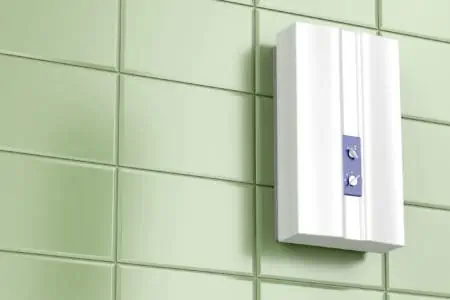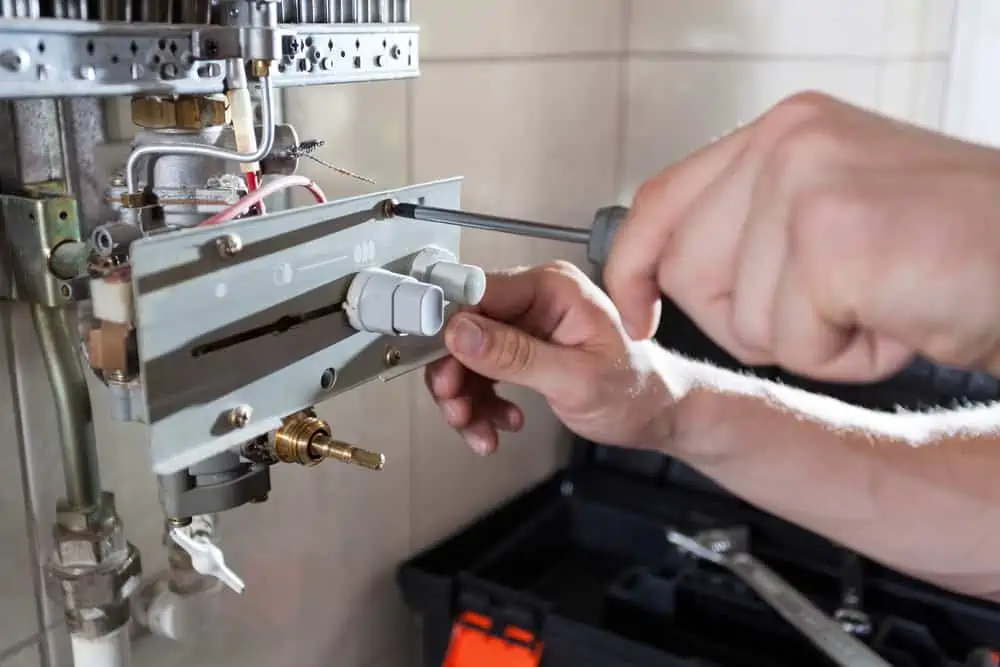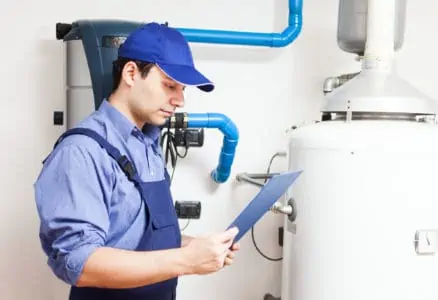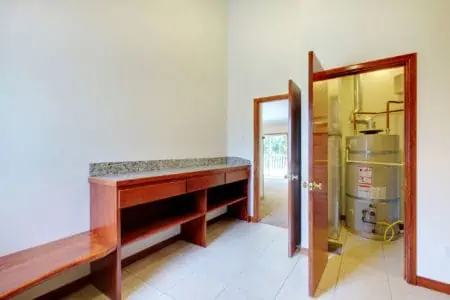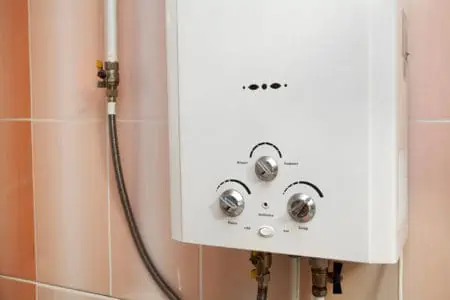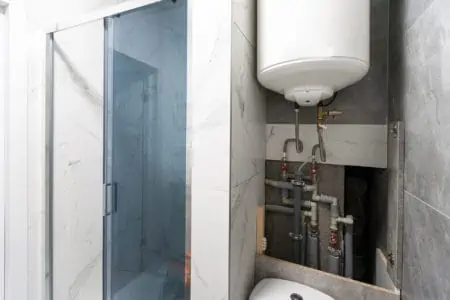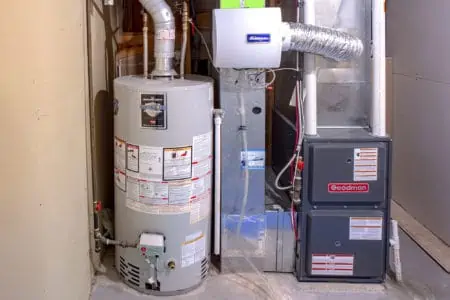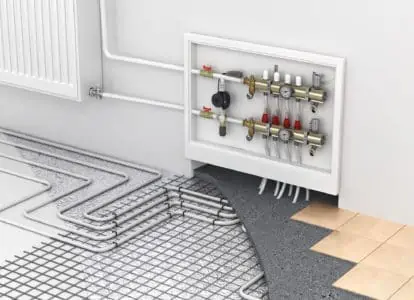Rinnai is a reliable and popular water heater brand, but sometimes they go wrong. If they do, you’ll need to know how to reset your Rinnai tankless water heater.
In this article, we discuss the Rinnai tankless water heater reset button and help you troubleshoot why you have a problem in the first place.
Key Takeaways
- Locate the Connect or Control-R button on the front panel of your Rinnai tankless water heater.
- Turn off the cold water supply, close hot water faucets, and open cold water ones to drain the system.
- Press and hold the button until the LED lights blink from red to white, or follow the specific reset sequence for your model.
- Reconnect the water supply, open hot water faucets, and check for leaks or proper water temperature after resetting.
Where Is the Reset Button on a Rinnai Tankless Water Heater?
Look for the Connect button located on the front of your water heater. It will be next to the digital display and the control panel. When pressed in a particular sequence, it restores the heater back to the factory settings.
Take Note
If you reset the water heater, you will lose your bespoke settings and wireless network history.
How to Reset a Rinnai Tankless Water Heater
Resetting your Rinnai tankless water heater is pretty simple. Once you’ve located the Rinnai tankless water heater reset button, there are a few procedures you will need to perform.
- Turn off the cold water supply to the heater, close your hot water faucets and open the cold water ones. This drains the residual water from the system.
- Without an isolation switch, you will need to turn the water supply valve to your home clockwise to seal off the supply.
- Press the connect button on the front panel of your water heater. Sometimes this button is called the Control-R.
- Hold the button down, and the LED lights will blink from red to white. Some systems require you to press the control button, release it, and then press it three times in quick succession. The heater will start beeping three times to indicate a successful reset.
- Reconnect the water supply, open your hot water faucets and then shut them off when water appears.
- With the heater on, open the main water valve to allow water to flow again.
- Once the unit fills with water, it will automatically begin heating the water until it reaches temperature.
- Turn on the hot water faucets to check the water reaches temperature and inspect for leaks. If you are satisfied, shut them off.
- Feel around the base of the heater to check for leaks. If you feel water, turn off the heater and call a pro for help.
When to Reset a Rinnai Water Heater
You may need to reset your Rinnai water heater from time to time. Perhaps the heater is not working, and there is no hot water? Maybe you’re resetting it after a power outage, or an error code appeared on the digital display?
Wireless Network Change
If you change your network provider, you will need to reset the water heater to continue using the app on your smart device. You may also have wireless thermostats that talk to the heater via Wi-Fi.
Resetting the water heater takes it back to the default factory settings so that you can enter the new network codes.
Error Code
If an error code flashes on the digital display, you may need to return the heater to the factory settings. This may only be necessary for specific error codes. Your user manual will tell you what each code means, and you can also get the information on the Rinnai website.
Turning off the unit is sometimes the easiest way of troubleshooting your Rinnai tankless water heater.
Hard Reset
Sometimes you will need to perform a hard reset, a bit like rebooting your computer. It clears the heater’s memory and enables you to start reprogramming from scratch.
If you’ve performed the reset procedure correctly and the heater won’t reset, you may need to call in a professional to help diagnose the problem.
Factory Reset Vs. Power Cycle
There are two ways to get your water heater back up and running: you can reset the default factory settings or use the power cycle method. What’s the difference? Let’s take a look.
Factory Settings
When your Rinnai tankless water heater was first installed, it was a blank canvas. There was no information stored in the memory, and it was set to the factory default settings.
When you reset the water heater, you wipe its memory and restore it to how it was on day one.
This method has advantages and disadvantages. The main plus is that it wipes any errors and restores the machine instantly. The downside is you lose all your saved data, including your Wi-Fi settings.
It’s worth noting that not all Rinnai tankless water heaters reset in the same way. Some have a button that you access with a pin or other small object, others have a Control-R button, and some have a connect button.
Follow the advice of your user manual to get the exact reset sequence for your model.
Power Cycle
Using the power cycle setting is a quicker fix than a total reset. It’s the equivalent of switching off your computer at the wall socket, waiting a few seconds, and then switching it back on.
The advantage is you get to keep all the stored information, but the disadvantage is it is not as thorough as a reset. You might still see an error code on the display.
Take Note
You should always attempt a power cycle before using the reset button. The reset button should be your last option after investigating all other routes. If the problems still exist, then press the reset button.
What Causes My Reset Button to Trip?
There are several reasons why the reset button trips on your Rinnai tankless water heater. Luckily, it’s not a common occurrence, so there is usually a good reason when it does happen.
Power Outage
You may experience a power outage, which causes your water heater to shut down. As a fail-safe, when the heater loses power, it may reset to the factory default settings. Unfortunately, you will have to enter all your information again and reprogramme the unit from scratch.
You might notice the light is not on, or you get cold water when you run the faucet. These are all signs of a power outage.
High Water Temperature
The reset button might trip if the water passing through the heater gets too hot and damages the heat exchanger. If that happens, it could indicate a bigger thermostat problem.
Power Surge
You may experience a power surge that causes the breaker to shut down. This cuts the power to your water heater, and the reset button triggers.
Faulty Wiring
Faulty wiring could be another reason why your reset button triggers. Speak to an electrician to rectify the problem. There are strict National Electrical Codes dictating the gauge and load capacity of the wires.
FAQs
Final Thoughts
Resetting your Rinnai tankless water heater is a great way to solve the issues you may be experiencing, but it does come at a cost. Losing your stored information means you need to enter the data again, which is time-consuming and inconvenient.
Before you reach for the reset button, it’s worth trying the power cycle route first.
